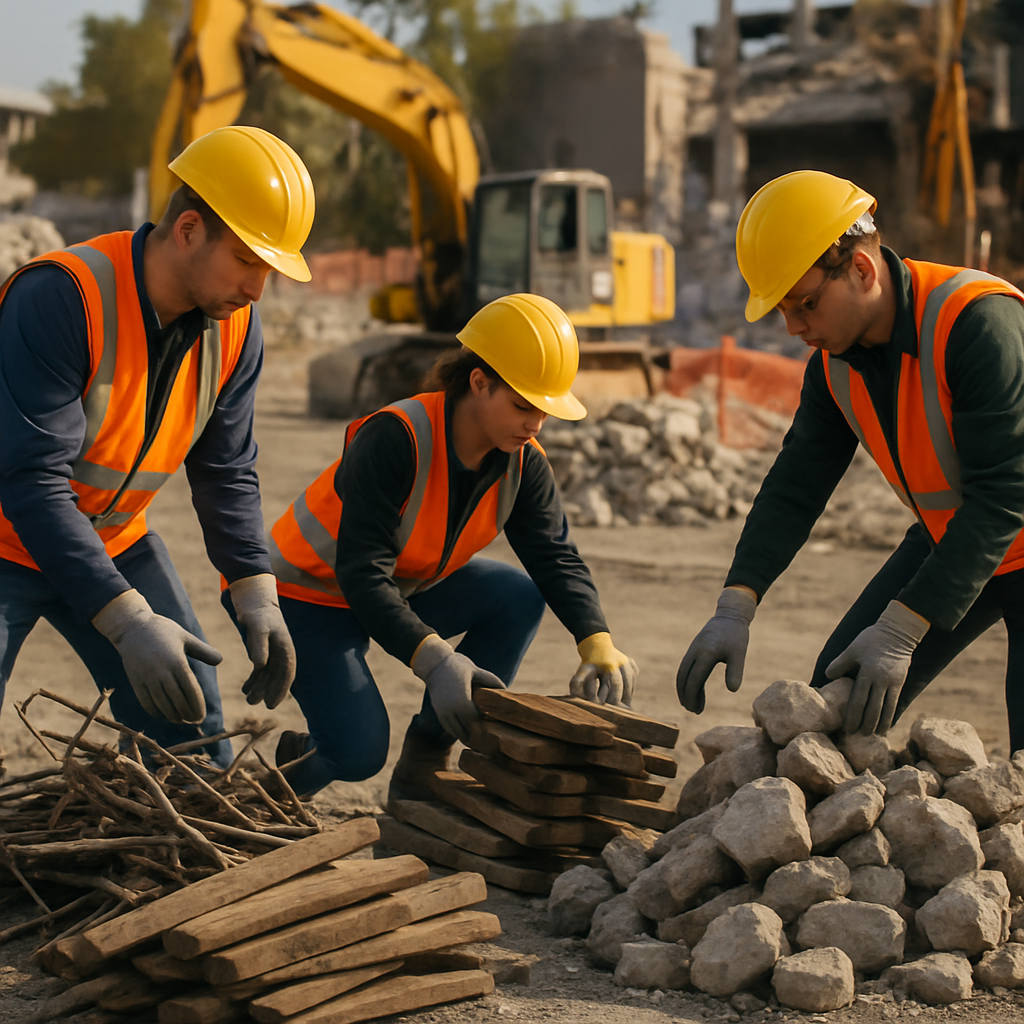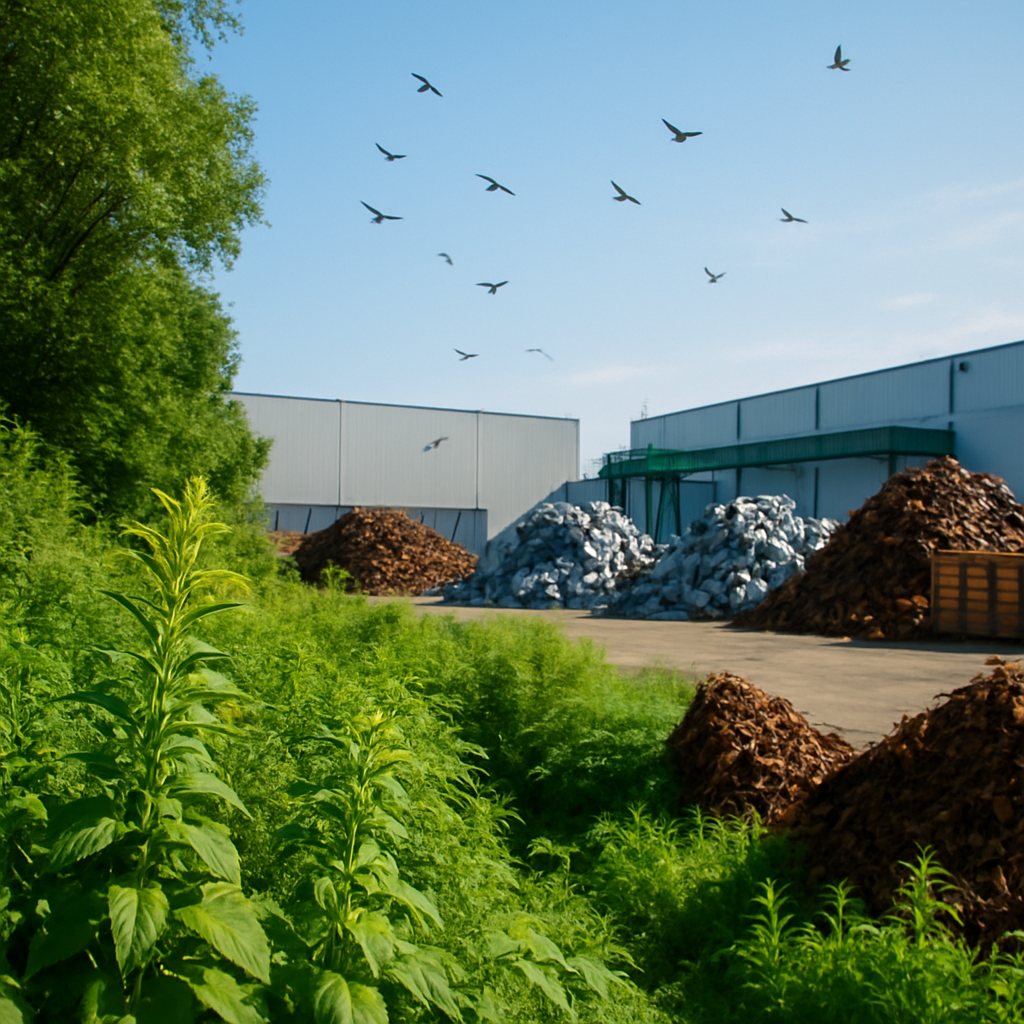5901 Botham Jean Blvd, Dallas, TX 75215
Demolition Scrap Processing: Techniques, Equipment, and Environmental Benefits
October 16, 2025When a building reaches the end of its lifecycle, it becomes a valuable resource repository. Demolition scrap processing involves systematically recovering and transforming materials from dismantled buildings and structures into reusable commodities. This detailed operation identifies, sorts, and prepares various metal types for their next lifecycle.
Demolition scrap processing aims to maximize material recovery while minimizing environmental impact. The process carefully separates two main categories of metals: ferrous metals containing iron, such as structural steel and rebar, and non-ferrous metals like copper wiring, aluminum siding, and brass fixtures.
The value proposition is compelling. Instead of treating demolition debris as waste destined for landfills, proper processing unlocks significant economic and environmental benefits. A well-executed demolition scrap operation can recover up to 95% of metal materials from a site, substantially offsetting project costs while conserving natural resources.
How is Demolition Scrap Sorted On-Site?

On-site sorting is crucial for profitable demolition recycling. When metals are segregated at the source, recycling facilities process them more efficiently and offer significantly higher payouts. This crucial step turns potential waste into valuable revenue and lowers disposal costs.
The Magnetic Separation Technique
The basic sorting method starts with magnetic separation. This straightforward technique distinguishes between ferrous and non-ferrous metals. Crew members use handheld magnets to test smaller items, while larger operations use magnetic separators mounted on equipment.
Ferrous metals, which contain iron, are attracted to magnets. These include structural steel, rebar, and cast iron pipes. While typically less valuable per pound than non-ferrous materials, their volume on demolition sites makes them worth collecting separately. Non-ferrous metals like copper, aluminum, and brass do not stick to magnets and generally fetch higher market prices.
Strategic Container Placement
Efficient on-site sorting requires a well-organized container system, best achieved when:
- Clearly labeled roll-off containers are strategically placed around the demolition site
- Containers are positioned for easy access by workers and equipment
- Separate bins are designated for ferrous metals, copper, aluminum, brass, and stainless steel
- Containers are located to minimize the travel distance for workers
This approach prevents cross-contamination between metal types and streamlines collection. Workers can quickly deposit materials in the appropriate container as they recover them, avoiding mixed piles that require re-sorting.
Crew Training and Quality Control
The human element is vital in effective scrap metal sorting. Crews need training to identify metal types and understand segregation’s importance. Workers should learn:
Basic metal identification techniques, such as magnet tests and visual inspection. The necessity of removing non-metallic attachments from valuable metals. The significant price difference between sorted and unsorted materials. Regular quality checks of sorted materials to prevent contamination.
Crew members who understand how proper sorting affects project profitability are typically more diligent about following protocols. Some companies offer incentives to encourage thorough sorting practices.
Advanced Identification Tools
For high-value demolition projects, portable metal analyzers provide precise material identification. These handheld devices use technologies like X-ray fluorescence to determine metals and alloys’ exact composition within seconds.
While these analyzers require an investment, they quickly pay off by ensuring accurate sorting of valuable materials, such as different grades of stainless steel or specialized alloys that might otherwise be misidentified. This technology is especially beneficial when dealing with modern buildings containing complex metal components.
Preparing Materials for Maximum Value
Beyond basic sorting, additional preparation significantly increases scrap metal value. Clean metals command higher prices than contaminated ones. Demolition teams maximize returns by:
Removing non-metallic attachments like plastic, rubber, or concrete. Separating different grades of the same metal, such as types of copper. Protecting sorted metals from weather exposure that could cause oxidation or contamination. Maintaining cleanliness standards for each material type.
These extra steps require some additional labor but typically deliver substantial financial returns. For example, clean copper without attachments or coatings can be worth 15-20% more than copper with insulation or contaminants attached.
The Financial Impact of Proper Sorting
The effort invested in on-site sorting translates directly into financial benefits. When metals arrive at recycling facilities already sorted, processors save on labor and operating costs. These savings are passed back to the demolition contractor through higher purchase prices.
Mixed scrap is deemed “dirty” and typically purchases at significantly lower rates because recycling facilities must spend time and resources sorting it. Properly sorted metals, by contrast, can often be processed immediately, creating advantages for both the demolition contractor and the recycler.
The price difference between sorted and unsorted scrap can be substantial. Well-sorted non-ferrous metals might command 20-30% higher prices than mixed loads. Even for lower-value ferrous metals, proper sorting can increase returns by 5-10%, which is significant when dealing with the large volumes typical in demolition projects.
What Equipment is Used in Demolition Scrap Processing?
Demolition scrap processing relies on specialized machinery designed to handle, separate, and prepare metals for recycling. The equipment used in this industry combines power with precision to efficiently transform demolition waste into valuable recyclable materials.
Electromagnets mounted on cranes are essential for ferrous metal recovery. These powerful magnets can lift and separate tons of steel and iron from mixed demolition debris in a single sweep. Unlike traditional grapples, electromagnets allow operators to release the material instantly by cutting the power, making the sorting process very efficient.
Metal shears come in various forms and are crucial for processing demolition scrap. Standard hydraulic shears slice through metal beams, pipes, and structural components with incredible force. High-reach shears are mounted on specialized excavators and can cut metals at heights of up to 100 feet, eliminating the need for risky manual demolition of tall structures.
On-site balers transform loose metal scraps into dense, transportable packages. These machines compress metals into uniform bales that maximize shipping efficiency. A single bale can contain what would otherwise fill multiple containers of loose scrap, substantially reducing transportation costs and environmental impact.
Crushing machines process bulkier metal components that cannot be easily cut. These robust devices exert tremendous pressure to flatten and condense metal objects. Some industrial crushers generate over 2,000 tons of crushing force, enough to compress an entire car into a dense metal block in under two minutes.
Precise cutting requires specialized torches for thicker or complex metal structures. Oxy-fuel torches can cut through steel several inches thick, while plasma cutters make clean, rapid cuts through various metals. These tools allow for strategic dismantling of structures when the recovery of specific metal components is necessary.
Mobile rotating shears attached to excavators provide flexibility in cutting larger pieces of metal on-site. These versatile attachments enable operators to maneuver through demolition sites and precisely cut metals to the desired size for processing, significantly reducing the need to transport oversized materials.
Concrete pulverizers play a critical role in separating metal reinforcement from concrete structures. These specialized attachments crush concrete while preserving the valuable rebar inside, which can then be collected and processed separately. This separation is essential for maximizing the recovery and value of metals from demolition sites.
Material handlers equipped with specialized grapples efficiently move and sort demolition materials. These machines feature booms that can reach extended distances while maintaining precise control. The most advanced models use joystick controls with haptic feedback, allowing operators to “feel” the materials they’re handling despite being separated by dozens of feet.
Portable metal balers and loggers provide on-site solutions for processing scrap in remote locations. These machines can be transported to demolition sites, eliminating the need to haul unprocessed materials to central facilities. This mobility is particularly valuable for projects in areas with limited access or transportation challenges.
What Are the Financial Benefits of Demolition Scrap Processing?

Demolition scrap processing turns what was once considered waste into a valuable revenue stream. The financial benefits of effective scrap management extend beyond simple disposal into strategic resource recovery. Let’s explore how demolition scrap processing generates measurable financial advantages for companies in the construction and demolition sectors.
The most significant financial advantage comes from generating revenue through the recovery of high-value metals. Non-ferrous metals like copper, aluminum, and brass fetch premium prices in recycling markets due to their value and reusability. Companies that implement strategic metal recovery can boost their profit margins by up to 30% simply by treating these materials as recyclable assets rather than waste.
Copper wiring from electrical systems and aluminum from structural components represent particularly lucrative recovery opportunities. A systematic approach to managing these materials creates a direct revenue stream that offsets project costs. In fact, the U.S. scrap recycling industry generates approximately $109.78 billion annually, demonstrating the substantial economic potential of proper scrap management.
Cost Reduction Through Lower Disposal Fees
In addition to generating revenue, demolition scrap processing significantly reduces waste disposal expenses. Landfill tipping fees continue to rise as available space decreases, making waste reduction financially advantageous. By diverting metals and other recyclable materials from the waste stream, companies can substantially lower their disposal costs.
Pre-demolition assessments play a crucial role in this cost-reduction strategy. Professional evaluations can identify recoverable materials that might otherwise be overlooked. These assessments typically enable companies to recover 15-25% more valuable materials from demolition sites, further reducing the volume of waste requiring disposal and the associated fees.
The systematic sorting of materials on-site maximizes this financial benefit. Clean, properly sorted scrap commands higher prices and streamlines the recycling process. Haphazard approaches to demolition waste management not only result in lost revenue but create logistical challenges that increase overall project costs.
Market Value and Pricing Considerations
The financial benefits of scrap processing are influenced by market conditions and metal prices. Global supply and demand dynamics affect the value of recovered materials, making it essential for demolition contractors to stay informed about market trends. Developing relationships with multiple recycling facilities can help secure the best prices for materials.
Steel recycling offers a prime example of financial efficiency. Recycling one ton of steel saves approximately 2,500 pounds of iron ore, 1,400 pounds of coal, and 120 pounds of limestone. These resource savings translate to significant cost reductions compared to using virgin materials. Similarly, aluminum recycling conserves about 95% of the energy required for primary production, representing substantial value in today’s energy-conscious market.
The financial benefits extend to improved supply chain resilience. Recycled metals can buffer against price volatility common in raw material markets. This predictability enhances financial planning and risk management, particularly valuable for operations with narrow profit margins.
Enhanced Project Profitability
When properly managed, scrap processing can transform a cost center into a profit generator. The combination of revenue from recovered materials and savings on disposal fees significantly improves overall project profitability. Companies with comprehensive scrap metal recycling programs position themselves for improved financial performance through multiple channels of cost reduction and revenue generation.
Additionally, businesses that demonstrate effective resource recovery enhance their competitive position when bidding on projects with sustainability requirements. As construction projects increasingly prioritize environmental responsibility, companies with established scrap processing protocols gain a valuable market advantage that leads to more business opportunities.
How Does Demolition Scrap Processing Impact the Environment?

Demolition scrap processing offers significant environmental benefits extending beyond simple waste management. When materials from demolition are properly processed and recycled instead of being sent to landfills, the positive impacts are substantial and widespread.
The diversion of demolition waste from landfills is among the most notable environmental advantages. Construction and demolition debris account for 25-40% of all solid waste globally. Processing and recycling these materials significantly decrease the volume of waste in burdened landfills, preventing soil and groundwater contamination while conserving valuable land resources.
Recycling scrap metals plays a vital role in conserving natural resources. Mining virgin materials leads to habitat destruction, soil erosion, and water pollution. By recycling metals from demolition sites, the need for new mining operations is minimized. For each ton of steel recycled, approximately 2,500 pounds of iron ore, 1,400 pounds of coal, and 120 pounds of limestone are conserved.
The energy savings from recycling demolition scrap are equally noteworthy. Recycling aluminum saves up to 95% of the energy required to produce it from raw ore. Steel recycling achieves energy savings between 60-74%, and copper recycling conserves approximately 85% of energy compared to its primary production. These energy reductions translate directly into decreased greenhouse gas emissions and air pollution.
Reducing the carbon footprint is another key benefit of demolition scrap processing. The EPA reports that metal recycling reduces greenhouse gas emissions by around 29 million tons of CO2 annually, equivalent to removing 6.3 million cars from the road. By processing and recycling demolition scrap, projects significantly reduce their overall carbon footprint.
Water conservation is also enhanced through demolition scrap processing. Mining and refining virgin metals require substantial water resources. Recycling metals from demolition waste can diminish water pollution by up to 76% and reduce water usage by around 40%. This preservation of water quality and quantity is increasingly crucial as many regions face water scarcity.
Beyond these immediate benefits, demolition scrap processing supports a circular economy model, where materials retain their utility indefinitely instead of following a linear take-make-dispose path. This method promotes sustainable resource utilization and greatly reduces the environmental impact of construction and demolition.
The collective environmental benefits of demolition scrap processing make it a crucial practice for sustainable waste management. As demolition techniques advance, the potential for greater material recovery and environmental protection will grow, supporting a more sustainable future for the construction and demolition industry.
Conclusion: The Future of Demolition Scrap Processing
Demolition scrap processing stands at the crossroads of resource conservation and economic opportunity. The industry has evolved from simple salvage operations to advanced recycling systems that recover valuable materials while minimizing environmental impact. AI-powered sorting technologies, robotics, and advanced recovery techniques are revolutionizing how demolition waste is processed. These innovations enable higher recovery rates and more efficient material separation, transforming what was once considered waste into valuable resources.
Looking ahead, the demolition scrap processing market is set for significant growth. Forecasts indicate the recycled metals market will almost double by 2034, growing from approximately $72 billion to $144 billion. This growth reflects increasing demand in the construction, electronics, and aerospace sectors. As urban mining gains prominence and circular economy principles become standard practice, demolition scrap will increasingly be viewed as an above-ground resource rather than waste. Companies that invest in sustainable processing methods will gain competitive advantages through resource security and regulatory compliance.
For guidance on implementing effective demolition scrap processing practices for your projects, contact Okon Recycling at 214-717-4083. Our expertise can help you maximize material recovery while minimizing environmental impact in your demolition operations.
